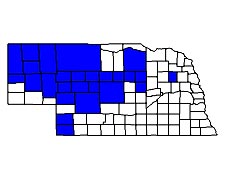
| Cicindela limbata limbata Say |
| Adult Length: 9 to 12 mm |
| Appearance: Adults have very heavy maculation, usually covering about two-thirds of the elytral surface. The maculation consists of a series of markings similar to those of C. repanda and C. hirticollis, but expanded so much so that virtually all lunules are fused and blend into one another. This results in a continuous broad band of maculation covering much of the elytral surface, with only one or a few small spaces of ground color evident within this band. As is the case in most Cicindela species, the degree of maculation is variable, and the markings may be somewhat reduced in a few individuals. Except for the broad pale maculations, the dorsal surface may be coppery red, coppery green, green, or blue. In some cases, the elytra may be a different color than the head and pronotum. The dominant color within populations appears to vary from one location to another. Some areas are dominated by blue or green individuals, while others are dominated by reddish individuals. The expanded pale maculations afford this little tiger beetle excellent camouflage in its preferred open sandy habitats. |
| Similar Species: The only species likely to be confused with this one is C. lepida. It too has heavy maculations and is likewise small, but it has dull brownish appendages, rather than metallic colored ones as in C. limbata. |
| Biology: Cicindela limbata occurs on sandy soils with little or no vegetation. It prefers blowouts and low areas between active dunes. It is most numerous where the sand is loose and subject to blowing. Though it can be found near C. formosa and C. scutellaris, this species prefers areas with the least vegetation and the loosest sand. When alarmed it usually flies only a short distance, but this is not always true. Sometimes adults are reluctant to fly and will only fly if closely approached. |
| Adult Life History: Adults emerge from the pupa in August and September and are active until mid-September and October before overwintering. Activity resumes in late April and early May, and peak numbers are reached in May and June. Numbers decline in July, and adults are scarce by early August. It is a spring-fall species. |
| Larval Life History: Larvae occur in blowouts and low spots between dunes where there is loose sandy soil. Larval burrows are about 30 cm in depth. Larvae apparently close their burrows during the hottest part of the year. It is believed that the larval stage lasts two years in Nebraska. |
| Biogeography: Within Nebraska, this species is restricted to mostly within the Sandhills Province. It has been recorded as far east as Stanton County and ranges across the sandy areas of the western half of the state. Though it is recorded from Sioux and Scotts Bluff Counties, its distribution there is likely very limited. In North America it occurs as three distinct geographical subspecies. The nominate subspecies occurs in Nebraska as well as northeastern Colorado, Wyoming, and South Dakota. Cicindela limbata nympha occurs in the Northern Plains from North Dakota and the extreme western edge of Minnesota through southwestern Manitoba to central Saskatchewan and Alberta. Cicindela limbata hyperborea occurs in the Athabaska dunelands of northern Alberta and Saskatchewan. A disjunct population occurs at Goose Bay, Labrador. Another population has very recently appeared in Alaska, this one with traits more like the nominate subspecies. Cicindela albissima was once considered a subspecies of C. limbata, but recent mitochondrial work shows it to be a distinct species. |




